Star Trek: The RPG by Hulk Smash!
Single Post
Original SA post
 Dear Diary: Today I just graduated from high school. I think I did pretty well, I think. My coach says I shouldn't have gambled on those games I played in but I'm the captain of the football team and I know my team. I also know a sure bet when I see one.
Dear Diary: Today I just graduated from high school. I think I did pretty well, I think. My coach says I shouldn't have gambled on those games I played in but I'm the captain of the football team and I know my team. I also know a sure bet when I see one.
 Dear Diary (supplemental): Oh, yeah, I sure hope my application to Starfleet Academy was accepted. Don't want to disappoint my dad.
Dear Diary (supplemental): Oh, yeah, I sure hope my application to Starfleet Academy was accepted. Don't want to disappoint my dad.
 Ernie! The mail's just arrived. Looks like your response from the academy is in there.
Ernie! The mail's just arrived. Looks like your response from the academy is in there.
 Coming Dad!
Dear Diary (sup. 2): Gotta Go!
Coming Dad!
Dear Diary (sup. 2): Gotta Go!
 Well, looks like you got in, son.
About time you made something of yourself.
Well, looks like you got in, son.
About time you made something of yourself.
 Wait 'till I tell Bert! He's going to be soooo jealous.
Wait 'till I tell Bert! He's going to be soooo jealous.
 Now, now, young man. You have to conduct yourself with the proper decorum when you're there. This is no joking matter. Why, when I was at the academy...
Now, now, young man. You have to conduct yourself with the proper decorum when you're there. This is no joking matter. Why, when I was at the academy...
 Yeah, yeah. Whatever, dad. See you!
Yeah, yeah. Whatever, dad. See you!
 Brat!
Brat!
quote:
This is Star Trek: The Roleplaying Game by FASA. It was first published in 1982 and discontinued in 1989. It's very much old school early 80's RPG design. The fluff was somewhat interesting since it came out at around the time of Wrath of Khan but before TNG and Star Trek Canon was not something that really existed. The game based its lore on the Original Series mostly and later published some supplements based on the first two movies. It also made use of the Animated Series and the books of a guy called John M. Ford. The differences in its lore and Canon is not too pronounced but there are some. I'll try to point them out as we go.
The way characters are created in the FASA RPG is by first rolling stats, in order, with 3d10 + 40 modified by racial attributes. You do this for Strength, Endurance, Intelligence, Dexterity, and Charisma. For the Luck and Psi Potential stats you simply roll a d100 and modify by racial attributes. Our boy Ernie rolled 14, 18, 13, 14, 20, 14 and 55. He then had a chance to roll a d100/2 and add the result to any stats. He chose to put 10 extra points in STR and 20 in INT All of this makes him pretty average except for a gifted intellect, above average strength and surprisingly high psi potential for a human.

Racial attribute modifiers
The next step was to define his pre-academy skills. This is done by dividing INT by 10 (round down) and rolling 1d10+5 per skill chosen from a set list. You can, if you want, pick the same skill more than once. As the captain of his high school's football team and occasional gambler, Ernie chose Trivia: Games, Language: Vulcan, Ground Vehicle Operation, Leadership, Small Unit Tactics, Personal Combat: Unarmed, and Gaming. He had 7 rolls to spend (INT 73) and chose to spread them around.
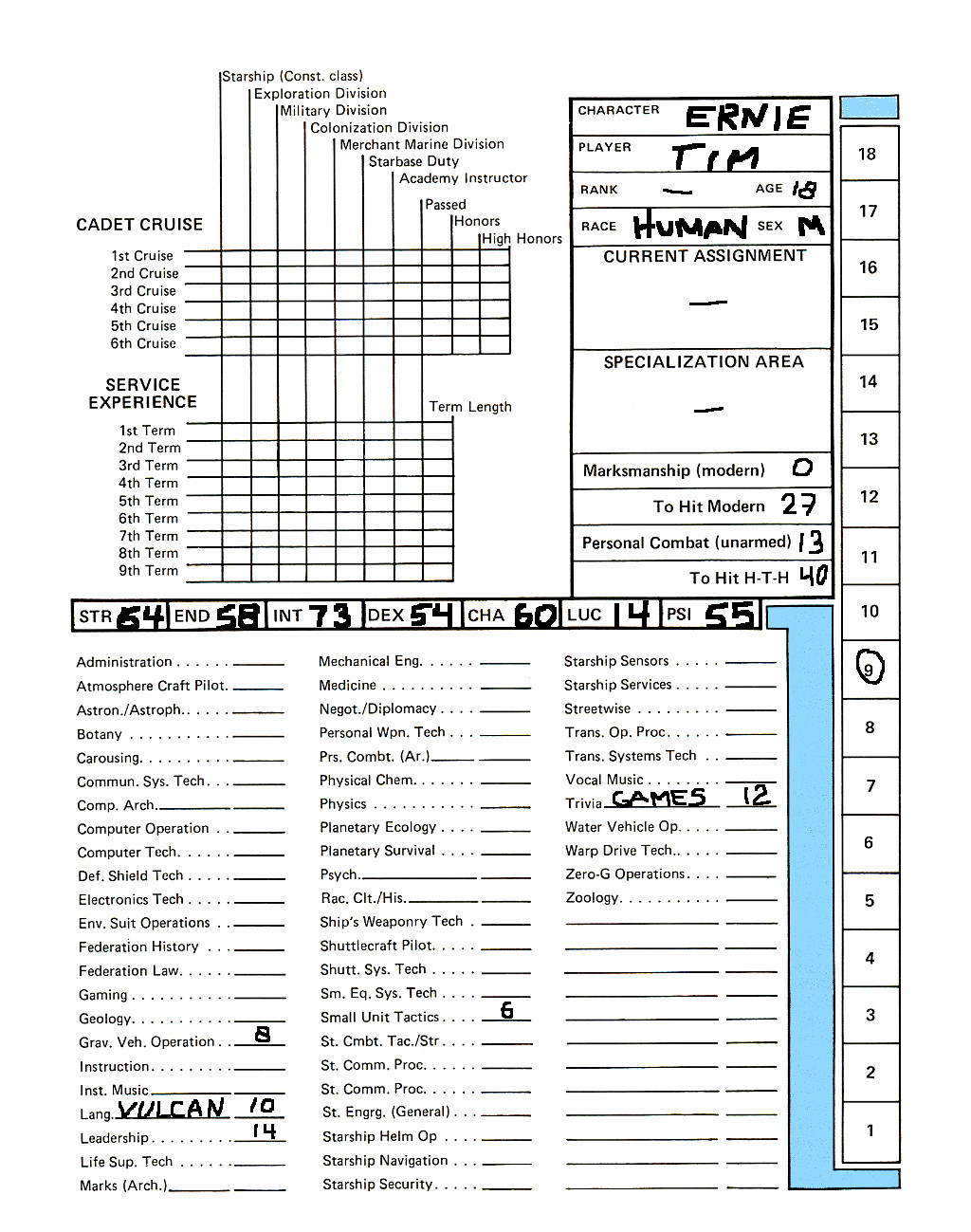
This is Ernie's pre-academy sheet
The next step is to see what skills are picked up at the academy.
 I can't believe I made it! Starfleet Academy! Just like my heroes James T. Kirk and Spock! I can't wait to have all kinds of adventures on exotic class M planets, see strange new worlds (also class M) and meet new life forms!
I can't believe I made it! Starfleet Academy! Just like my heroes James T. Kirk and Spock! I can't wait to have all kinds of adventures on exotic class M planets, see strange new worlds (also class M) and meet new life forms!
 Also: Green Women.
Also: Green Women.
 Hey, Ernie boy!
Hey, Ernie boy!
 Bert! You made it too?
Bert! You made it too?
 Yup. Going to be so great. What specialization did you pick?
Yup. Going to be so great. What specialization did you pick?
 Helm, you?
Helm, you?
 Security.
Security.
 Good luck with that
Good luck with that
 What was that?
What was that?
 Nothing.
Nothing.
 Well, got to get to class. See you later.
Well, got to get to class. See you later.
 You know, for an organization that prides itself on diversity, there aren't a lot of alien races here. All I see are Vulcans, Andorians, Caitian, Edoans and Tellarites.
You know, for an organization that prides itself on diversity, there aren't a lot of alien races here. All I see are Vulcans, Andorians, Caitian, Edoans and Tellarites.
 Greetings.
Greetings.
 Hi.
Hi.
 Hello.
Hello.
 Welcome.
Welcome.
 Oink.
Oink.
 Gah!
Gah!
quote:
ST:RPG offers 6 species choices (including humans) for player characters. Two of these, Caitian (cat people) and Edoans (three-armed and three legged freaks) are from the Animated Series. I believe that later supplements offered more choices and the Klingon and Romulan books gave some rules for playing those as well.
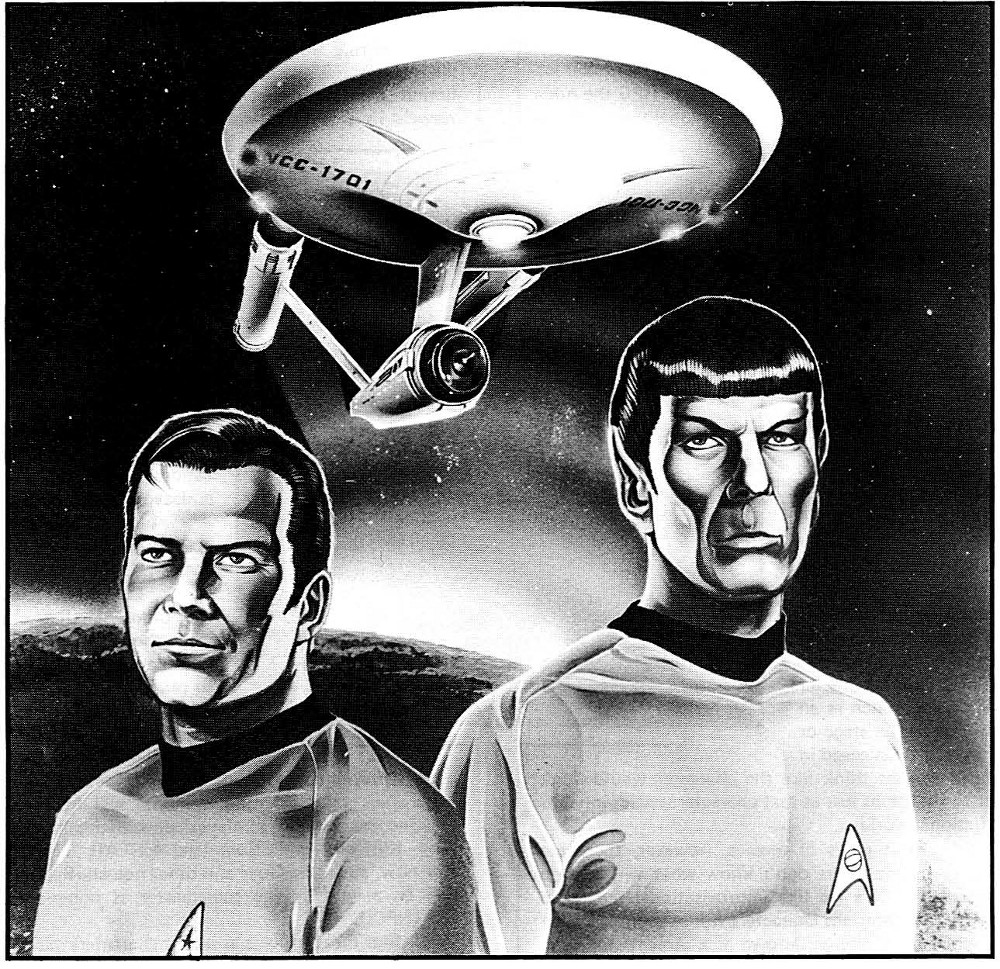
Ernie's heroes. Also the cover of the game
 Dear Diary: I've learned so much in the past 3 years. I've learned the inner workings of starship operations, leadership, more science classes than I cared for and even law studies. I think it was all worth it though. No way am I not getting a sweet posting after all that. Well, gotta go. Later, Diary.
Dear Diary: I've learned so much in the past 3 years. I've learned the inner workings of starship operations, leadership, more science classes than I cared for and even law studies. I think it was all worth it though. No way am I not getting a sweet posting after all that. Well, gotta go. Later, Diary.
 I can't believe I made it trough 3 years of academy training. That shit's hard!
I can't believe I made it trough 3 years of academy training. That shit's hard!
 Yeah, no kidding. Half of my classmates in security training died. And those were training missions!
Yeah, no kidding. Half of my classmates in security training died. And those were training missions!
 anyway. Now we get to go on our cadet cruises. Boy, oh, boy. I sure hope that I get assigned a Constitution class starship!
anyway. Now we get to go on our cadet cruises. Boy, oh, boy. I sure hope that I get assigned a Constitution class starship!

 Hey, guys.
Hey, guys.

 Hi, Tibia.
Hi, Tibia.
 Are you waiting for the cadet cruise postings?
Are you waiting for the cadet cruise postings?
 Yeah. Here's the list of postings now. What did you guys get.
Yeah. Here's the list of postings now. What did you guys get.
 Military Division. USS Armstrong.
Military Division. USS Armstrong.
 Nice!
Nice!
 Constitution Class. USS Yamato.
Constitution Class. USS Yamato.
 Very nice!
lucky bastard
Very nice!
lucky bastard
 Here comes yours, Ernie. Looks like you got...uh, Merchant Marine Division. USS Trawler.
Here comes yours, Ernie. Looks like you got...uh, Merchant Marine Division. USS Trawler.
 Well, shit.
Well, shit.
quote:
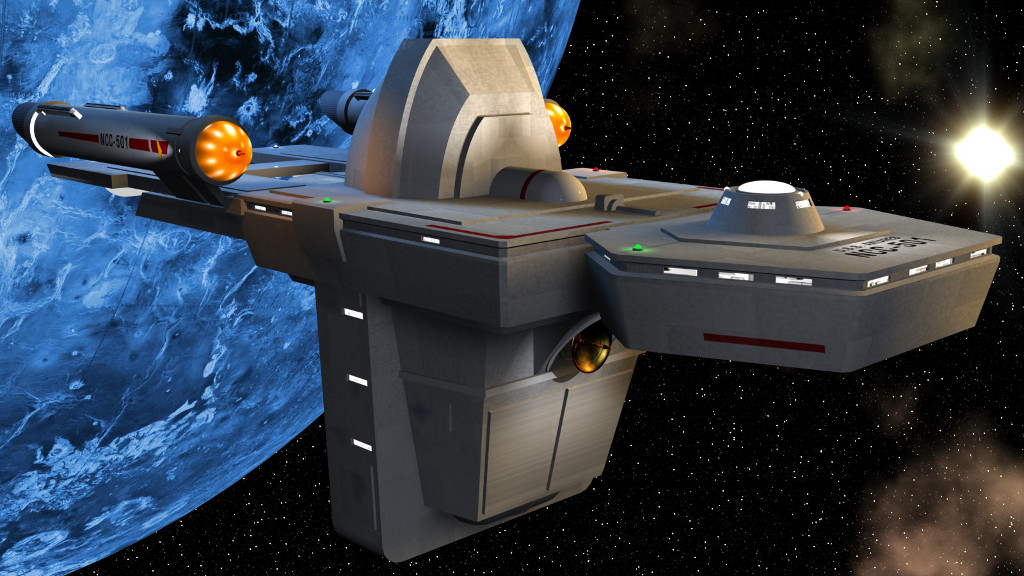
Ernie's Cadet Cruise ship
Academy time is normally 4 years long. The first 3 are spent in classes, learning various skills and the last one is the Cadet Cruise. This is where the cadets are posted on real, active ships and starbases and are graded by actual field officers.
The basic skills that everyone learns at the academy are: Administration (10), Astronomy/Astrophysics (10), Computer Operations (20), Federation History (10), Federation Law (10), Instruction (10), Language (any) (10), Leadership (10), Marksmanship (modern) (10), and Personal Combat: Unarmed (20).
As a member of the Helmsman group, Ernie also gets the following: Astronomy/Astrophysics (15), Computer Operations (10), Computer Technology (15), Electronics Technology (20), Ship's Weaponry Technology (20), Shuttlecraft Pilot (20), Starship Combat Strategy/Tactics (20), Starship Communication Procedures (20), Starship Engineering (general) (10), Starship Helm Operations (40), Starship Navigation (20), and Starship Sensors (20).
he also gets INT/10 (round up this time) number of 1d10 rolls to add to his Helmsman specialization. He chooses Starship Helm Operations (+8), Shuttlecraft Pilot (+4 and +4), Starship Navigation (+10), Ship's Weaponry Technology (+2 and +3), and Starship Sensors (+1 and +5).
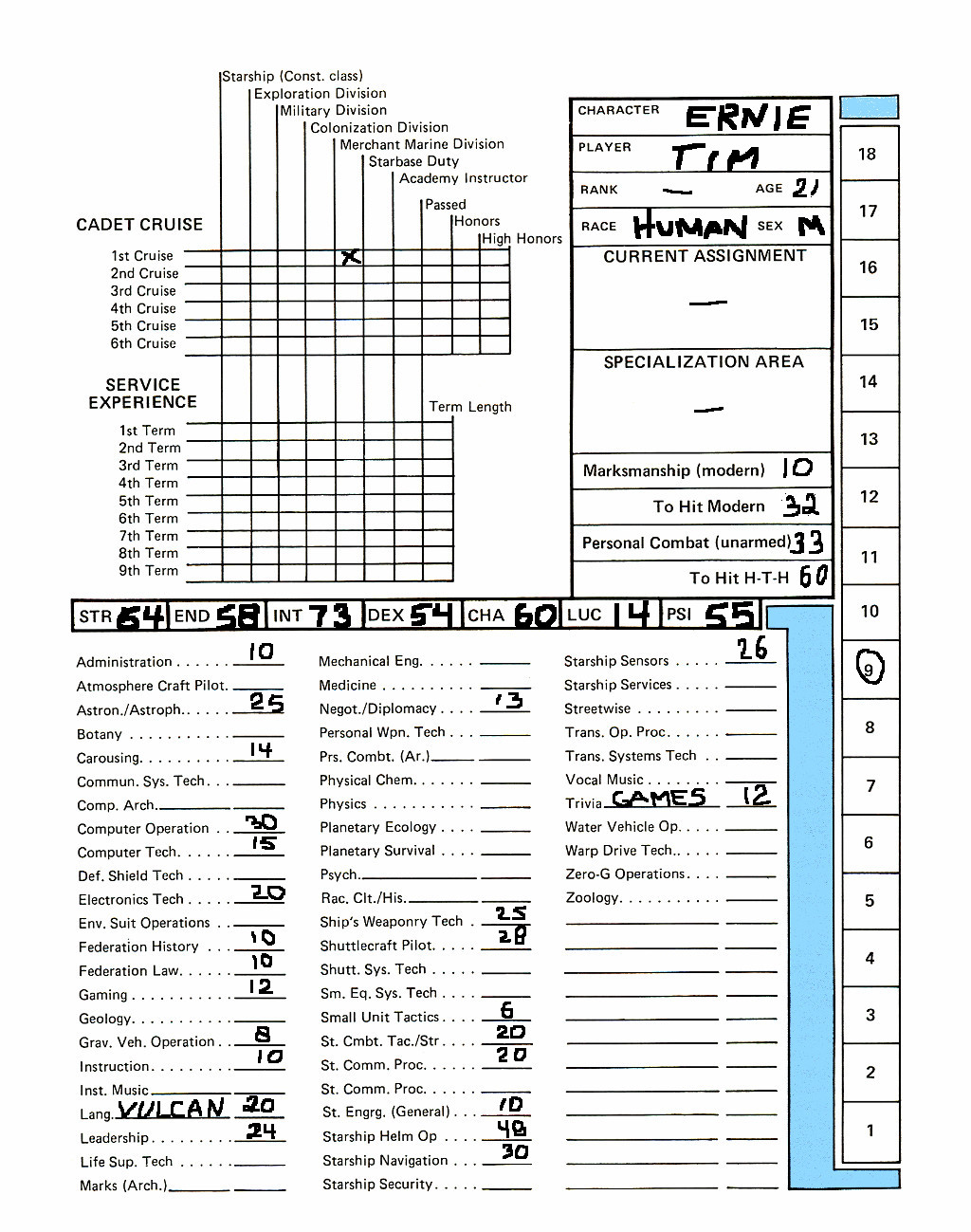
Ernie's sheet just before his cadet cruise
On the cadet cruise you get to roll to see how well you did. You roll a d100 modified by your posting and LUCK. Lower rolls are better. Roll too high and you get to repeat the cadet cruise. Once completed, characters graduate and get promoted to Ensign (unless in Medical Specialty where you get posted as LT. Junior Grade since you entered the academy after your MD was completed). Using this table:
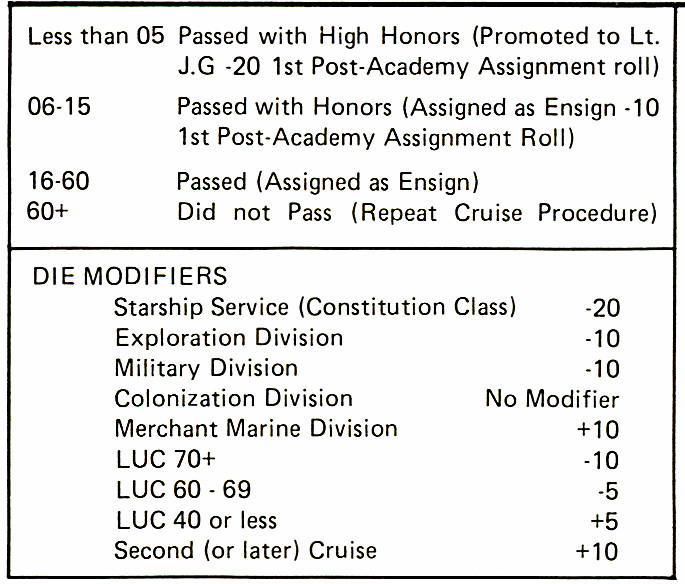
Ernie rolls d100 (+5 for his luck and +10 for merchant marine) and gets a 46 (+15) = 59. This gets him a result of Passed (barely) and he gets promoted to Ensign. Incidentally, this chart makes it that it's easier to get good results if you're posted on prime assignments. Essentially, what should be the tougher postings (cutting edge starship exploring the unknown VS a starbase in bumfuck sector) is easier to ace. Makes you wonder if Kirk and Co. got their dues legitimately.
Upon completion of the cadet cruise you also get to add 5 1d10 rolls to any skills. Ernie adds 13 to diplomacy (3 rolls) and 14 to Carousing (2 rolls). This will be reflected in his next sheet update.
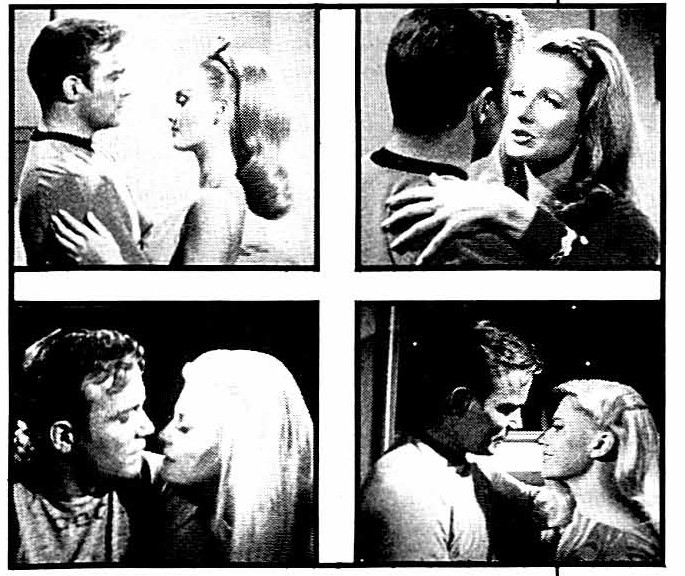
The Carousing skill in action
 Dear Diary: Man, that cadet cruise was bullshit. All we did for a whole year was to run between starbase 1 and starbase 2 hauling crates of dehydrated mashed potatoes. Life in Starfleet might not be what I hoped it would be. Hopefully Bert had a shitty time too.
Dear Diary: Man, that cadet cruise was bullshit. All we did for a whole year was to run between starbase 1 and starbase 2 hauling crates of dehydrated mashed potatoes. Life in Starfleet might not be what I hoped it would be. Hopefully Bert had a shitty time too.
 Hey, Ernie. How was your Cadet Cruise?
Hey, Ernie. How was your Cadet Cruise?
 Great! Just... great. How was yours?
Great! Just... great. How was yours?
 Oh, man. We went to this planet called “Orion”. You would
not
believe the girls there! Then I went on this away team. Every one died but me. They gave me a medal and I got this sweet promotion to LT. JG.
Oh, man. We went to this planet called “Orion”. You would
not
believe the girls there! Then I went on this away team. Every one died but me. They gave me a medal and I got this sweet promotion to LT. JG.
 If you think I'm going to salute you...
If you think I'm going to salute you...
 C'mon. I wouldn't do that to you. You know that.
C'mon. I wouldn't do that to you. You know that.
 Hm. Well, let's go see what's in store for our next posting.
Hm. Well, let's go see what's in store for our next posting.
 Hey, the USS Armstrong wants me back. Cool! And you got sponsored to command school! Lucky break, eh?
Hey, the USS Armstrong wants me back. Cool! And you got sponsored to command school! Lucky break, eh?
 Uh. Wow. Command? Me?
I deserve this, dammit!
I guess I'll see you in a couple of years, eh, Bert? I wonder who could have recommended me for this?
Uh. Wow. Command? Me?
I deserve this, dammit!
I guess I'll see you in a couple of years, eh, Bert? I wonder who could have recommended me for this?
 Isn't your dad an admiral?
Isn't your dad an admiral?

quote:
Characters who are destined for command, we're told, get to go to command school for two years. These characters include PCs who are to be department heads (the Sulus and Scottys of this world), first officers (Spock pulling double duty as department head and FO) or Captains.
Going to command school gives you the following skills: Administration (30), Computer Operations (20), Federation History (20), Federation Law (20), Instruction (20), Leadership (30), Negotiation/Diplomacy (20) and Starship Combat Tactics/Strategy (20). You also get a bump in rank by one increment.
After command school (or cadet cruise if no command school), the next step is to generate post-academy experience. This is not a mandatory step. If the game is to take place straight out of academy we'd be done. You generate post-academy stuff long enough for the character to reach the appropriate rank/experience for whatever game setting the GM and players decided on.
For each 2 years of service post-academy (and pre-game) the character gets 1d10 to roll to augment any skill. He also gets more or less skill rolls based on INT and LUC
we also get rules stating that for each full 10 years beyond the character's critical age (50 for humans) that we get to reduce each stat by 1d10. So it makes sense to only advance pre-game while still relatively young.
 Can you believe that we finally got posted to the same ship, Bert? The USS [Insert Name Here] might not be the biggest ship around but, at last, I'm on an actual starship going on actual missions.
Can you believe that we finally got posted to the same ship, Bert? The USS [Insert Name Here] might not be the biggest ship around but, at last, I'm on an actual starship going on actual missions.
 Weird ship name though.
Weird ship name though.
 Anyway. The captain's called us to the transporter room. We're to beam down and investigate the strange gaseous anomalies on the surface. Someone said they heard one talk. Something about a huge lizard man too.
Anyway. The captain's called us to the transporter room. We're to beam down and investigate the strange gaseous anomalies on the surface. Someone said they heard one talk. Something about a huge lizard man too.
 Look, here's the rest of our away team. Ensign Forehead and Ensign Tribble. Ladies (?)
Look, here's the rest of our away team. Ensign Forehead and Ensign Tribble. Ladies (?)
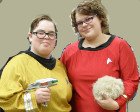 Hello, Sirs.
Hello, Sirs.

 Energize.
Energize.
*bzzzuuuuum*
 Graaarrr!
Graaarrr!
 Oh, God. Shoot it!
Oh, God. Shoot it!
 Damn it, I missed.
Damn it, I missed.
 Graaarrr!
Graaarrr!
 Aghkgfgd!
Aghkgfgd!
 Eat phaser, beast!
Eat phaser, beast!
 Graaarrglk!
Graaarrglk!
 Good shot, Ernie.
Good shot, Ernie.
 And take
that!
And take
that!

 Oh, no! The Ensigns caught the full brunt of the attack. We may have to use mouth-to-mouth resuscitation.
Oh, no! The Ensigns caught the full brunt of the attack. We may have to use mouth-to-mouth resuscitation.
 I'm not really good at first aid, you know? Why don't you do that?
Also: dammit, Bert, I'm a helmsman, not a doctor and all that.
I'm not really good at first aid, you know? Why don't you do that?
Also: dammit, Bert, I'm a helmsman, not a doctor and all that.
 It's no use. They're dead, Ernie.
It's no use. They're dead, Ernie.
 Bummer. Anyway, back to the ship?
Bummer. Anyway, back to the ship?
quote:
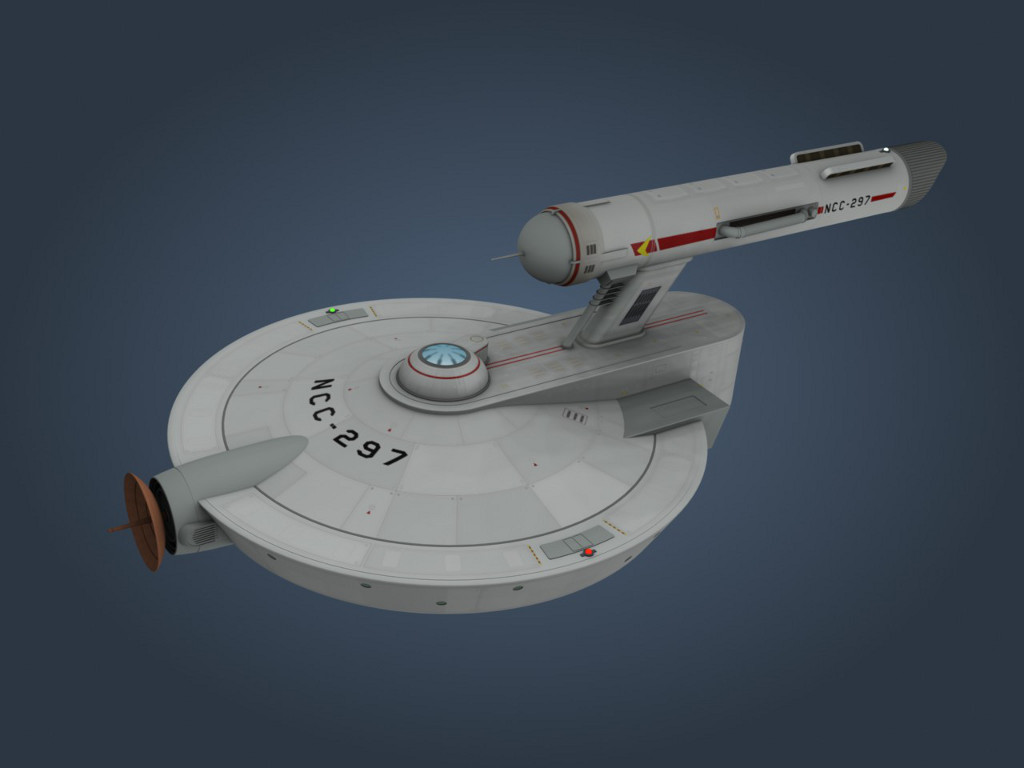
The USS [Insert Name Here]
Combat in the FASA ST:RPG is handled using a grid. Initiative is handled from highest DEX to lowest and characters get to spend Action Points (AP) to, well, perform actions. Each action as a set cost and you can spend as much as your AP allows. The number of AP one gets is DEX/10 (round down) +4. AP costs are, among others, 1 for moving one square in a straight line, 1 and ½ for diagonal movement, 2 for drawing a weapon, 1 for firing and so on.
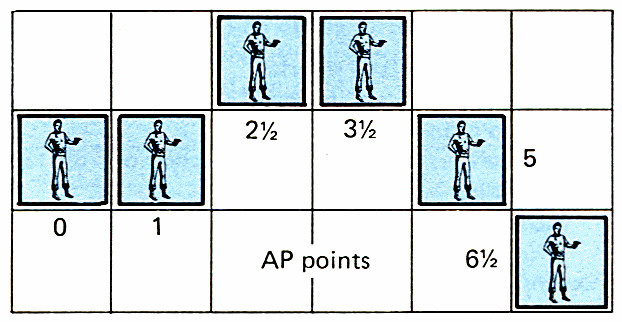
Movement using AP
To calculate your chances to hit, you add DEX + Weapon Skill/2 (which I think I messed up on the earlier sheets but fuck if I'm correcting that. The final sheet will be Ok). You then roll a d100 under it to score a hit. This d100 roll is modified by distance, target size and cover. You then get to roll damage. For most melee or non-energy weapons this is handled as xd10+y. For energy weapons, such as phasers, it depends on the weapons current setting. For example, a phaser on stun will cause 75pts of non-permanent damage. On disintegrate, the target is automatically destroyed. There are grazing rules to make sure that not every successful hit on that setting results in disintegration. Damage is taken directly from the END stat. Reach 0 and die.
Firing an energy weapon also causes drain. Drain is the amount of power removed from the weapons total – basically ammo. There's also discussion of firing arcs and most of the hallmarks of Star Trek combat such as Vulcan nerve pinches, setting a weapon on overload and Karate chopping a Gorn in the neck.
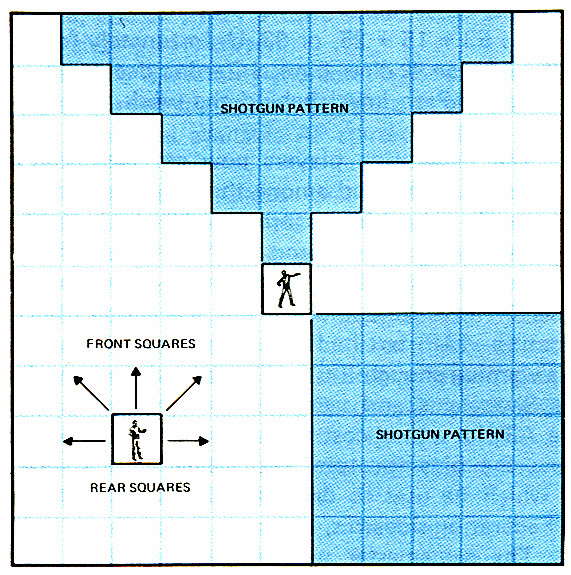
Firing arcs of a shotgun
In Ernie's combat the Gorn got the jump on them but Bert's high DEX made him attack first. Unfortunately with a roll of 89 he missed. The Gorn then attacked the Ensigns and his high STR allowed him to flatten them with a boulder for 3d10 damage. Ernie, being the heroic dude that he is, had his phaser set to disintegrate and hit the Gorn square in the chest with a roll of 13 . At this point it didn't matter what the Gorn's END score was.
 Dear Diary: I got promoted to full Lieutenant for my heroic actions on Ceti Beta 2. Saving those colonists from the fembots of Harry Mudd sure was fun! We're now on patrol on the border of the Triangle. Hope we don't run into any trouble.
Dear Diary: I got promoted to full Lieutenant for my heroic actions on Ceti Beta 2. Saving those colonists from the fembots of Harry Mudd sure was fun! We're now on patrol on the border of the Triangle. Hope we don't run into any trouble.
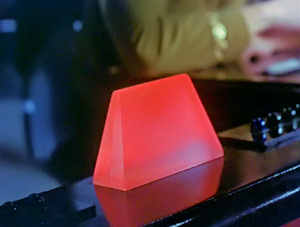
 Dear Diary (supplemental): Gotta go
Dear Diary (supplemental): Gotta go
 Klingons on the port bow, sir!
Klingons on the port bow, sir!
 On screen.
On screen.
 *Generic Klingon threat about territory*
*Generic Klingon threat about territory*
 Sir, they've cut off communications. They're preparing to fire.
Sir, they've cut off communications. They're preparing to fire.
 Shields up! Fire phasers!
Shields up! Fire phasers!
 Sweet.
Sweet.
 Fire!
Fire!
 Oh, no! Somehow the console I was standing next to dangerously exploded from that one phaser hit.
Oh, no! Somehow the console I was standing next to dangerously exploded from that one phaser hit.
 Fire torpedoes.
Fire torpedoes.
 Direct hit on their warp core.
Direct hit on their warp core.
 You'll never take me alive, human scum.
You'll never take me alive, human scum.
*boooom!*
 Nurse Chattel, check on LT Bert.
Nurse Chattel, check on LT Bert.
 He's dead, Ernie.
He's dead, Ernie.
 You Klingon bastards, you killed my friend!
You Klingon bastards, you killed my friend!
quote:
First a note on the Triangle. In this version of Star Trek this is the lawless area that is wedged between the Federation, Romulan and Klingon sectors. It's where most of the adventures from the supplement “Trader Captains and Merchant Prince” took place. Then there's the Klingons. In this version, the Klingons are distinctly divided between “Imperial Klingons” (with forehead ridges from the 1st two movies) coming from their homeworld of “Klinzhai” and “Human-Hybrid Klingons” (i.e. TOS ones) which are basically genetically altered Klingons made to look more human. This was thought to make them better at understanding (and fighting) humans.
Now, as for starship combat, this game does have rules for that too. This is also grid based but this time we're to use a Hex grid. I think that it's partly based on the board game Starfleet Battles but I'm not sure as I've never played it. At any rate, each major position (captain, engineering, helm, and navigation) gets something to do during ship combat. The captain gives the orders, the engineer gets to allocate points from a pool to a track for shield, power, and weapons' systems – he also makes the repair rolls to “heal” damage, the helmsman gets to fly the ship by allocating points to the warp speed track, rolling for sharp turns to avoid stress to the ship, the navigation officer rolls to raise the shields in time and allocate power to the weapons, communications gets to track ship casualties and the science officer runs the sensors to get info on the target. Medical and Security don't get to do anything starship combat related according to the rules I have.
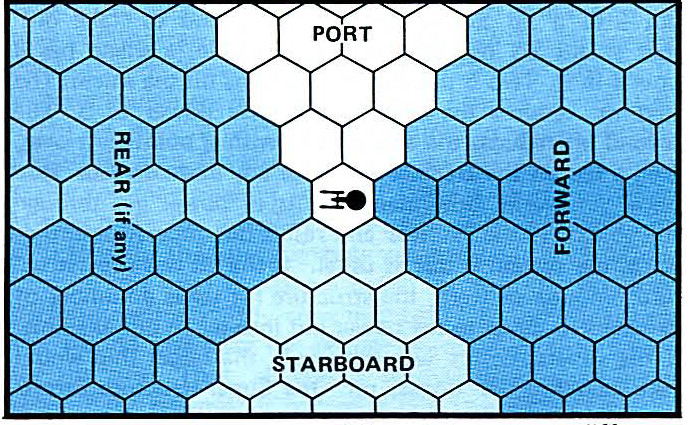
Ship's weapons firing arcs
The basic sequence is to:
1) Who has tactical advantage (Captain skill roll for each ship)
2) Winner decides who moves first
3) Side 1 moves
4) Side 2 moves
5) turn the ships to have the facing you want
Then:
1) Available power determined by engineer
2) Power channeled to weapons, shields ect. by department heads
3) Keep track of power usage as you go
Finally, when firing:
1) Captain orders fire
2) Helmsman determines the range
3) Helmsman makes to hit roll
4) Determine damage (this is a set number based on the weapon, the range and the power allocated
5) Damage applied to opposing ship based on hit location rolled
If on the receiving end:
1) Determine which hex side is hit
2) See if shields hold
3) If not, apply damage to system hit
Basically it looks like you end up playing a completely new game anytime ship combat comes around. Probably great for the people into simulation boardgaming, not so much for the more story-centric folks.
If a ship is destroyed (or set to self-destruct) then the damage it produces is equal to its remaining power points, modified by distance. And, yes, there are rules for exploding consoles – it wouldn't be Star Trek otherwise.
quote:
The rule book also contains rules for creating flaura and fauna on planets, calculating civilization levels (it's a chart from 0 – 10 for various categories such as technology, psi level and chemistry, where about a 7 represents current (well, 1982) day earth. The Federation's a 9 almost everywhere. Here's a randomly generated planet for the hell of it:
1) It's a system with 1 class M world (rolled a 16 on d100)
2) It has 3 satellites, none of which are class M (rolled a 9 on a d10)
3) The world has a 0.6 gravity (rolled 6 on 1d10/10)
4) It has a 31 hour day (rolled 17 on d10+14)
5) It has a normal atmospheric density (rolled 7 on d10)
6) It has a 92% land and 8% water surface (rolled 92 on d100)
7) It has temperate-cool climate (rolled 63 on d100)
8) It is composed of 83% normal minerals, 04% special minerals, 18% radioactive minerals, 52% gemstones and 69% industrial minerals (rolled a bunch of d100 for % of each)
9) It has elephant sized non sentient mammal life forms (rolled 67 on d100 and above 10% chance of sentience and then 2d10 for size and got a 16)
We then get a brief history of the Federation (TOS episode descriptions, really), some technology descriptions (from tricorders to phasers) no stats, just flavor text, gamemaster advice and the last section which is design notes. Apparently the ground combat is based on another FASA game called Grav Ball. The designers liked it so much they used it almost wholesale.
 Dear Diary: my tour on the last ship is over. I'd just as soon forget it but I will not forget Bert. I dedicate the rest of my career to you, Bert. Today I find out my next assignment
Dear Diary: my tour on the last ship is over. I'd just as soon forget it but I will not forget Bert. I dedicate the rest of my career to you, Bert. Today I find out my next assignment
 Dear First Officer's Log: I'm on my way up! I'm now a Lieutenant Commander and serving as the First Officer on a fancy exploration ship under Captain Robau. My new ship, the USS Kelvin, is a beauty. Nothing's gonna stop me now
Dear First Officer's Log: I'm on my way up! I'm now a Lieutenant Commander and serving as the First Officer on a fancy exploration ship under Captain Robau. My new ship, the USS Kelvin, is a beauty. Nothing's gonna stop me now
 Something's coming up on sensors, captain. On screen.
Something's coming up on sensors, captain. On screen.
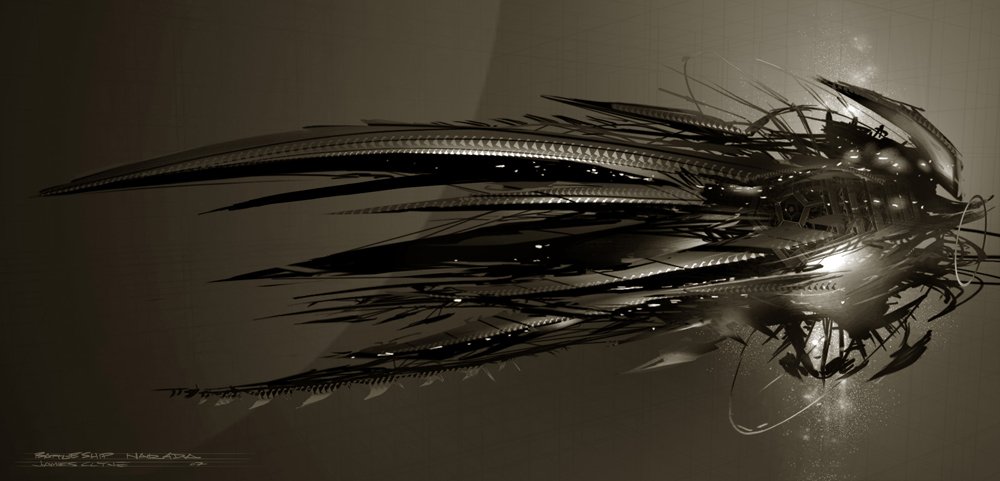
 Well, shit.
Well, shit.
quote:
Here's Ernie's final character sheet after 2 tours of duty post-academy. He served one on an exploration vessel and another on a starbase, for a total of 8 years of post-academy duty prior to the “game”.
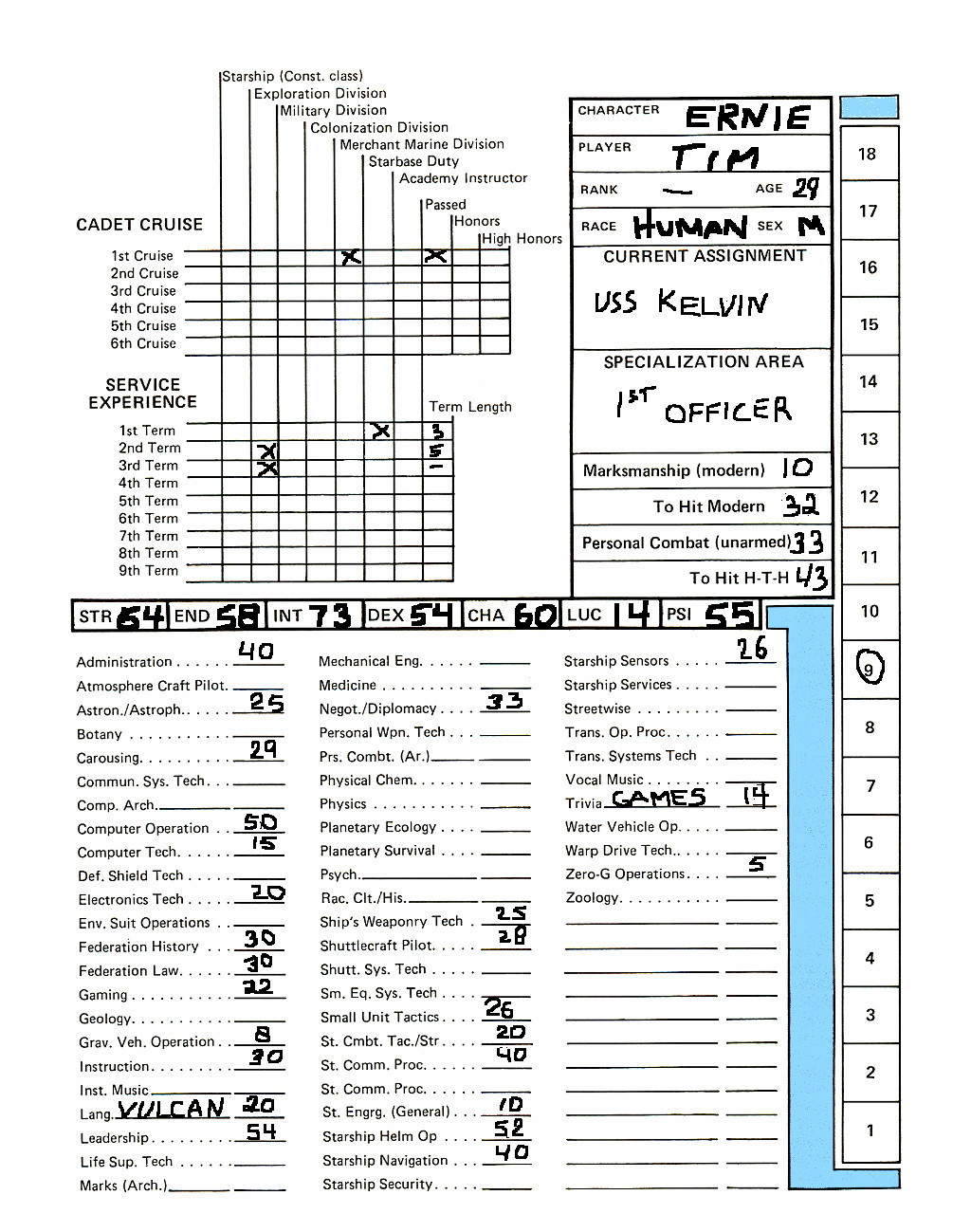
For comparison, here are Kirk and Spock's sheets.
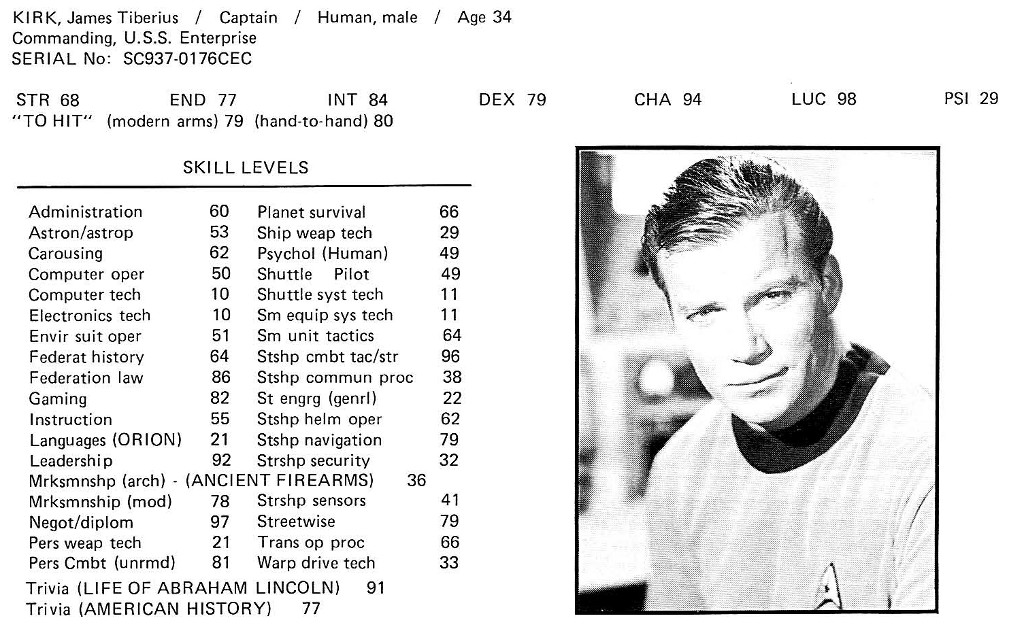
Captain Kirk
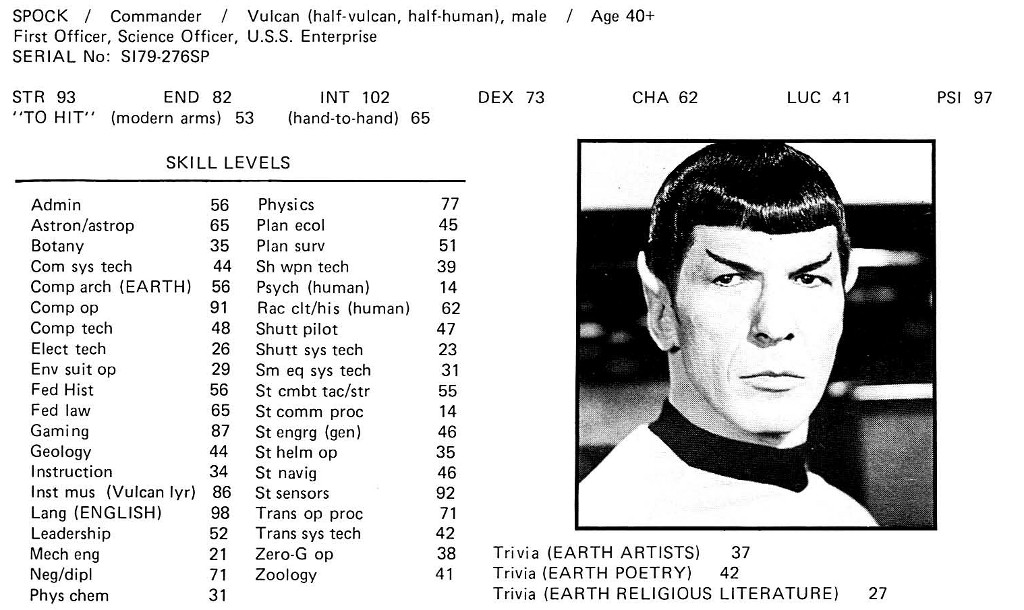
Spock